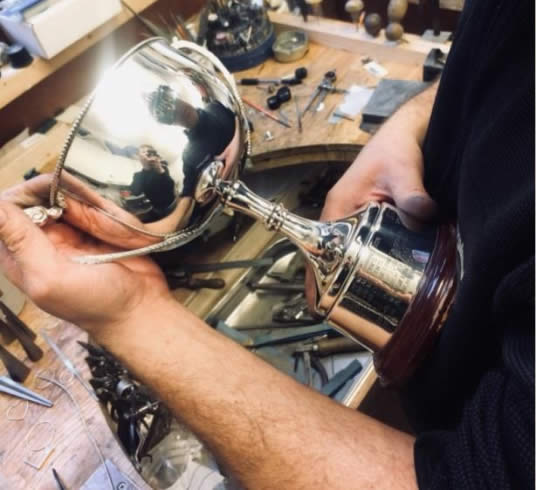Silver Restoration in London
The Art of Silverware Restoration: Reviving Timeless Elegance
Silverware has long been a symbol of elegance, tradition, and luxury. Whether it's a family heirloom passed down through generations or a valuable piece acquired for its beauty, silverware often holds sentimental and historical significance. Over time, however, silver can tarnish, become scratched, or even suffer from more serious damage. That's where silverware restoration comes into play, breathing new life into these timeless treasures and ensuring they continue to shine for years to come.

What is Silverware Restoration?
Silverware restoration is a specialized process that aims to return silver objects, such as cutlery, trays, candlesticks, and serving pieces, to their original beauty. This can involve several techniques, from polishing and cleaning to repairing cracks and dents. The goal is not only to remove tarnish and restore shine but also to maintain the integrity and value of the silver item, especially for antique or rare pieces.
Silverware restoration is more than just a cleaning process; it is an art form that requires knowledge of materials, techniques, and an understanding of the historical value of each piece. Whether you're dealing with everyday flatware or a unique heirloom, skilled restoration can help preserve the aesthetic appeal and functionality of your silverware.
Common Silverware Issues
Over time, silverware can encounter a variety of issues that may diminish its beauty or function. Some of the most common problems include:
- Tarnish: Silver naturally tarnishes when it reacts with sulfur in the air, leading to a dull, darkened surface. This is one of the most common issues with silverware, but it can easily be removed through polishing.
- Scratches: Silver is a relatively soft metal, and regular use can lead to scratches and wear on the surface, especially in items like flatware or serving trays.
- Dents and Damage: Silverware that has been dropped or mishandled can suffer from dents or bends. This can be particularly problematic for antique pieces, where restoring the original shape is crucial.
- Broken Pieces: In some cases, silverware may become cracked or broken. Repairing broken handles, joints, or other parts requires expertise to restore both function and appearance.
- Loss of Detail: Over time, intricate designs or engravings on silver items may become faded or worn down. Restoration can help bring back fine details to ensure the piece's original charm is preserved.
The Restoration Process
The process of restoring silverware can vary depending on the specific issues a piece has, but it generally involves a few key steps:
- Assessment: The first step is a thorough assessment of the item to identify any tarnish, damage, or areas requiring special attention. A professional restorer will evaluate the extent of the damage and determine the best approach to restore the item.
- Cleaning and Polishing: One of the first tasks in the restoration process is to remove tarnish. This is often done using a gentle polishing technique with a specialized silver polish that removes tarnish without damaging the metal. For heavily tarnished items, more intensive cleaning methods, such as electrolysis or ultrasonic cleaning, may be used.
- Repairs: If the silverware has any dents, cracks, or broken parts, skilled silversmiths will use various techniques to repair the piece. This might involve reshaping metal, soldering joints, or replacing broken components. For items with intricate designs, repair work requires precision to match the original look.
- Replating (if needed): In some cases, especially with older silver-plated items, replating may be necessary. This involves applying a fresh layer of silver to the surface to restore its shine and protect the metal from further tarnish.
- Re-engraving or Re-carving: If the original engraving or design has worn away, some restoration services offer re-engraving to bring back the fine details. This is especially important for antique or personalized silverware.
- Final Inspection: Once the restoration process is complete, a final inspection is performed to ensure that the silverware is in pristine condition. This includes checking for any remaining tarnish, assessing the quality of repairs, and ensuring that the item is functional and aesthetically pleasing.
Why Consider Silverware Restoration?
- Preserving Sentimental Value: Many silverware pieces are family heirlooms or gifts that hold sentimental value. Restoring these items ensures that they can be passed down through generations in pristine condition, preserving their sentimental and historical significance.
- Enhancing Aesthetic Appeal: Silverware restoration brings back the shine and beauty of your silver items, enhancing their visual appeal. Restored silver can become the centerpiece of your dining table or home décor once again.
- Increasing Value: For antique or rare silverware, proper restoration can increase or preserve the value of the item. Restoring a tarnished or damaged piece of silver can help retain its investment value, especially for collectors or investors.
- Eco-Friendly Option: Rather than discarding old or damaged silverware, restoration allows you to recycle and reuse valuable pieces, making it an environmentally friendly alternative to buying new items.
- Functionality: Beyond aesthetics, restoration ensures that your silverware remains fully functional. Broken handles, dents, or cracks can compromise the usability of the item, but with restoration, your silverware can once again be used for special occasions or daily use.
Tips for Caring for Restored Silverware
Once your silverware has been restored, it’s important to take proper care of it to maintain its beauty. Here are a few tips:
- Regular Cleaning: Gently clean your silverware after each use to remove fingerprints and food residue. Use a soft cloth or mild soap and water, and dry thoroughly to prevent water spots.
- Store Properly: Store your silverware in a dry, cool place to prevent tarnishing. You can use anti-tarnish cloths or bags to protect items from exposure to air and moisture.
- Avoid Abrasive Materials: When polishing, avoid using abrasive cloths or cleaning products that could scratch the surface of the silver. Stick to soft, non-abrasive materials.
- Professional Maintenance: For heavily used or valuable pieces, consider having your silverware professionally cleaned and maintained periodically.
